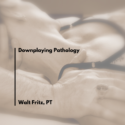Downplaying pathology.

One of my favorite podcasts is Dr. Oliver Thomson’s Words Matter. Through his podcast, Dr. Thomson addresses a wide range of topics relevant to my practice, both as a physical therapist as well as an educator. While an entire hour spent unpacking concepts surrounding the way a clinician approaches a patient presenting with back pain may sound rather niche-y and not of particular interest to an SLP, voice professional, or other professionals, but the episode that I just finished listening to is completely relevant for all of us. If you can broaden the context to include all aspects of diagnoses and envision how our patients enter our clinic, you’ll see the immediate relevance of the information covered in this episode.
One of the takeaways is revealed in the portion of the talk that looks at patient expectations in how we assess, and the expectation of all of the things that we will find wrong with the patient. Much of this feeds into the traditional medical model that is ramped up in manual therapy evaluations. Our patients pay us to find out what is wrong with them and then do things to make them less wrong. In past articles I’ve covered my views on concepts of causation and pathology and how, when presented in the silo-based format of a specific manual therapy mindset, makes us seem the expert on finding problems with their fascia (or joint, or muscle, or trigger points). They expect this from us, but by telling them what is wrong, we may be doing a disservice at many levels. First off, our silo-based training makes every problem look like a problem based on our training. In my post life as an MFR therapist, every problem was explained in fascial-based language. But that language, and the concepts that underpinned it, are not ones accepted by the outside medical community. So by telling my patient what was wrong with their fascia, I may have been telling mistrusts. Second, by telling what is wrong with them I am reinforcing how broken they are. Sure, I am offering solutions (my services), but layering on pathological perceptions builds strongly on nocebic concepts (not a good thing).
In the podcast episode, Dr. Thomson and his guest, Dr. Ben Darlow, speak about how reinforcing the positive during an evaluation can step our patients back from the edge of feeling broken. While most want a diagnosis, what most really want is reassurance that they are NOT broken.
Most patients come to us having seen a few other professionals and, most likely, have been told some rather sorry explanations for why they are having problems. If the poor input came from someone at the top of the food chain, such as the ortho surgeon, or similar, those explanations are hard to undo. One cannot forget what they’ve already heard. But many of the bad explanations for problems come from those on a equivalent level, professional-wise. It’s not easy to undo the crappy thoughts injected into our patient’s brains by others, but we can start by telling our patients what is NOT wrong as we assess. The podcast explains this much better than I can, and there are a whole lot more gems that I believe all will benefit from.
You can listen to the entire podcast from the links at this page.
Cheers,
Walt Fritz, PT
Foundations in Manual Therapy Seminars and The Pain Relief Center
Please consider checking out my online course offerings, , including a full hands-on online course. You can find the information here. Also, read up on my in-person seminars at the links in the menu on this page.



Sorry, comments are closed for this post.